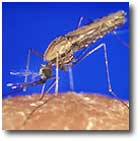|
Melbourne scientists have made the surprise discovery that malaria parasites can ‘talk’ to each other, a social behaviour to ensure the parasite’s survival and improve its chances of being transmitted to other
humans.

The finding could provide a niche for developing antimalarial drugs and vaccines that prevent or treat the disease by cutting these communication
networks.
Professor Alan Cowman, Dr Neta Regev-Rudzki, Dr Danny Wilson and colleagues from the Walter and Eliza Hall Institute's Infection and Immunity division, in collaboration with Professor Andrew Hill from the University of Melbourne’s Bio21 Institute and Department of Biochemistry and Molecular Biology showed that malaria parasites are able to send out messages to communicate with other malaria parasites in the body. The study was published in the journal
Cell.
Professor Cowman said the researchers were shocked to discover that malaria parasites work in unison to enhance ‘activation’ into sexually mature forms that can be picked up by mosquitoes, which are the carriers of this deadly disease.
“When Neta showed me the data, I was absolutely amazed, I couldn’t believe it,” Professor Cowman said. “We repeated the experiments many times in many different ways before I really started to believe that these parasites were signalling to each other and communicating. But we came to appreciate why the malaria parasite really needs this mechanism – it needs to know how many other parasites are in the human to sense when is the right time to activate into sexual forms that give it the best chance of being transmitted back to the
mosquito.”
Malaria kills about 700,000 people a year, mostly children aged under five and pregnant women. Every year, hundreds of millions of people are infected with the malaria parasite, Plasmodium, which is transmitted through mosquito bites. It is estimated that half the world’s population is at risk of contracting malaria, with the disease being concentrated in tropical and subtropical regions including many of Australia’s near
neighbours.
Dr Regev-Rudzki said the malaria parasites inside red blood cells communicate by sending packages of DNA to each other during the blood stage of infection. “We showed that the parasites inside infected red blood cells can send little packets of information from one parasite to another, particularly in response to stress,” she
said.
The communication network is a social behaviour that has evolved to signal when the parasites should complete their lifecycle and be transmitted back to a mosquito, Dr Regev-Rudzki said. “Once they receive this information, they change their fate – the signals tell the parasites to become sexual forms, which are the forms of the malaria parasite that can live and replicate in the mosquito, ensuring the parasites survives and is transmitted to another
human.”
Professor Cowman said he hopes to see the discovery pave the way to new antimalarial drugs or vaccines for preventing malaria. “This discovery has fundamentally changed our view of the malaria parasite and is a big step in understanding how the malaria parasite survives and is transmitted,” he said. “The next step is to identify the molecules involved in this signalling process, and ways that we could block these communication networks to block the transmission of malaria from the human to the mosquito. That would be the ultimate goal.”
This project was supported by the National Health and Medical Research Council of Australia, Howard Hughes Medical Institute and the Victorian
Government.
For more information
Cell-Cell Communication between Malaria-Infected Red Blood Cells via Exosome-like Vesicles
http://www.cell.com/abstract/S0092-8674%2813%2900504-7
The Walter and Eliza Hall Institute of Medical Research
(MDN)
|
![]()